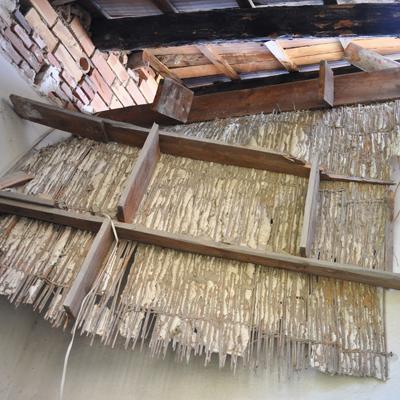Architetto, Dipartimento di Architettura, Università di Bologna
giulia.favaretto_309
ABILITÀ TRADIZIONALI ED EMERGENTI
La salvaguardia della cultura richiede conoscenze sempre più trasversali per affrontare le sfide complesse poste dal patrimonio culturale. Competenze consolidate di documentazione, diagnostica e restauro, si associano ad abilità di disseminazione, networking e coinvolgimento delle comunità. Il testo presenta alcuni risultati di ricerca del progetto Horizon 2020 4CH - Competence Centre for the Conservation of Cultural Heritage, volto alla definizione del quadro metodologico e organizzativo di un Centro di Competenza (CC) che, a livello europeo e nazionale, fornirà supporto, consulenza e servizi in questo campo. L’identificazione di competenze e abilità, tradizionali ed emergenti, è stata svolta a partire dalla lettura critica di documenti di indirizzo, buone pratiche e programmi di formazione, con l’obiettivo di definire attraverso quali attività il futuro CC potrà migliorarne lo sviluppo.
TRADITIONAL AND EMERGING SKILLS
The safeguarding of culture requires increasingly transversal knowledge to face the complex challenges posed by cultural heritage. Consolidated competences in documentation, diagnostic and restoration are combined with dissemination, networking and community involvement skills. The paper presents some research results of the Horizon 2020 4CH - Competence Centre for the Conservation of Cultural Heritage project, aimed at the definition of the methodological and organisational framework of a Competence Centre (CC) which will provide support, consultancy and services in this field at European and national level. The identification of traditional and emerging skills has been carried out starting from the critical reading of policy documents, good practices and training programmes, with the aim of defining through which activities the future CC will be able to enhance their development.
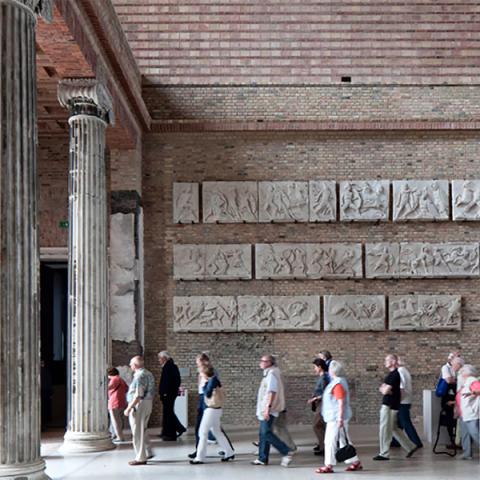
PATRIMONIO CULTURALE E CAPACITY BUILDING
Nell’era dell’Antropocene, ovvero dell’attuale epoca geologica segnata da un ambiente terrestre fortemente condizionato dagli effetti delle azioni dell’uomo, i cambiamenti climatici in atto impongono di agire seguendo la rotta dello sviluppo sostenibile. In quest’ottica, l’adozione di un modello di economia circolare consente di delineare strategie capaci di coinvolgere molteplici dimensioni, come quella ambientale, energetica e culturale.
Il presente contributo si colloca all’interno di tale scenario e, nel farlo, espone le strategie di capacity building in corso di definizione nell’ambito del progetto BECK, orientate a fornire un apporto utile alla conservazione e al miglioramento del comportamento energetico del patrimonio culturale. In questo senso, l’individuazione e la diffusione di possibili scenari d’azione costituiscono una parte integrante di tale percorso multiculturale e multidisciplinare.
CULTURAL HERITAGE AND CAPACITY BUILDING
In the age of Anthropocene, the current geological age marked by an Earth environment strongly influenced by the effects of human actions, climate change requires actions along the route of sustainable development. In this perspective, the adoption of a circular economy model makes it possible to outline strategies capable of involving multiple dimensions, such as the environmental, energy and cultural ones.
This paper lies within this scenario and, in so doing, it presents the capacity building strategies under definition in the BECK project, oriented to provide a useful contribution to the conservation and improvement of energy behaviour of cultural heritage. In this sense, the identification and diffusion of possible scenarios of action constitute an integral part of this multicultural and multidisciplinary path.
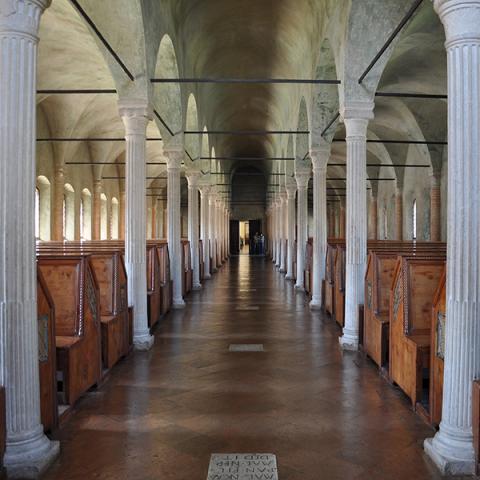
L’importazione delle acquisizioni, l’esportazione delle esperienze
I restauri di Villa Tugendhat a Brno consentono di avviare una riflessione sul destino del patrimonio del XX secolo. Attraverso l’analisi degli approcci e la descrizione degli esiti, il contributo si pone l’obiettivo di valutare le operazioni condotte secondo una duplice visuale: le importazioni delle acquisizioni e l’esportazione delle esperienze. Incroci e trasferimenti portano a una riflessione conclusiva sulla conservazione del patrimonio del XX secolo, anche non tutelato ma di valore riconosciuto, nonché sulla possibilità di conferire nuovi significati a produzioni architettoniche ieri sconosciute, oggi apprezzate.
The importation of acquisitions, the exportation of experiences
The restoration interventions of Villa Tugendhat in Brno allow to open a reflection on the destiny of the 20th century heritage. Through the analysis of the approaches and the description of the results, this paper aims at evaluating the operations that have been carried out according to a double view: the importation of acquisitions and the exportation of experiences. Intersections and transfers lead to a final reflection on the conservation of the 20th century heritage, that may not be safeguarded but which could have a recognised value, as well as on the possibility of conferring new meanings to architectures which yesterday were unknown and today are appreciated.
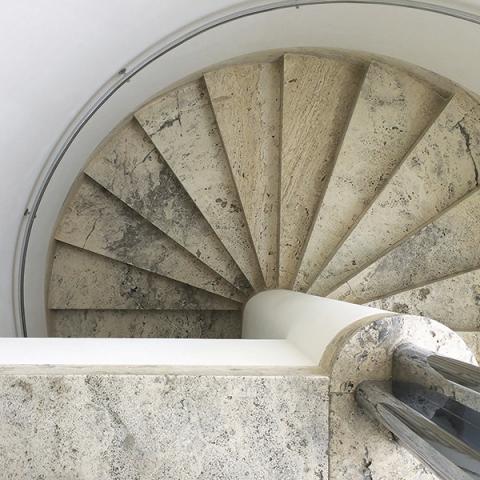
“DOMUS CONSTRUCTA CANNIS”
I sistemi costruttivi in camorcanna costituiscono un’eredità architettonica del patrimonio edificato storico che, per la particolarità delle tecniche costruttive e l’impiego di materiali della tradizione locale, rappresentano una preziosa e ricca testimonianza di una cultura del saper fare che merita di essere tutelata e trasmessa.
Il presente articolo si struttura come un approfondimento delle questioni metodologico-operative, proposte dalla letteratura esistente in materia, connesse al recupero e alla conservazione di tale patrimonio costruttivo. Alla descrizione delle cause di degrado e di dissesto che, per fattori intrinseci o estrinseci alla costruzione, si riscontrano con maggior frequenza su siffatti sistemi costruttivi, segue un excursus sulle principali tecniche di intervento e sui materiali generalmente impiegati per il consolidamento finalizzato al recupero dei sistemi in camorcanna.
Alla luce delle suddette considerazioni, il contributo si configura come un invito ad affrontare la fase operativa dell’intervento sull’esistente con quella necessaria consapevolezza critica che solo deriva dalla profonda conoscenza del manufatto - momento imprescindibile per un intervento responsabile sulla materia storica - senza mai dimenticare quelli che sono i principi guida del progetto di restauro architettonico.
“DOMUS CONSTRUCTA CANNIS”
Camorcanna constructive systems represent a precious architectural heritage that belongs to our historic building patrimony. The peculiarities of this type of technique and the use of traditional local materials, are the reasons why they constitute an evidence of an active culture of know-how that has to be preserved.
This article focus on the methodological and operative matters related to the rehabilitation and the conservation of this constructive heritage, aspects which have been investigated by the existing connected literature. The description of the most frequent causes of degradation and instability that can be observed in these constructive systems precedes an excursus on the main techniques of intervention and on the materials that are generally used for the rehabilitation of camorcanna systems.
The article is a call to face the intervention of conservation with the necessary critical awareness that can derive only from a deep knowledge of the historic building, awareness that cannot forget the guiding principles of the restoration project.
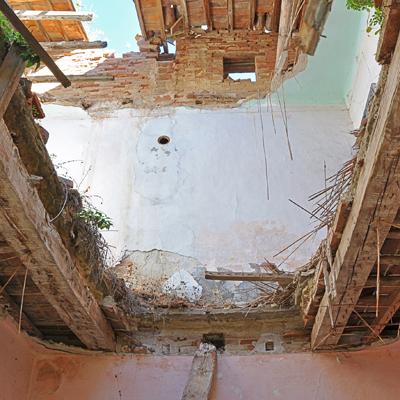
“DOMUS CONSTRUCTA CANNIS”
L’edilizia tradizionale è da sempre depositaria di un saper costruire secondo regole che ascoltano i suggerimenti offerti dalla natura ed è testimonianza, con la sua consistenza materiale, del profondo legame che sussisteva tra architettura e ambiente circostante.
Tale assioma può essere facilmente riscontrato nell’edilizia storica romagnola, la quale costituisce un modello insediativo che risulta di grande interesse per le sue attitudini costruttive in quanto caratterizzato da uno stretto ed inscindibile rapporto tra culture materiali e territorio circostante. I materiali da costruzione utilizzati, facili da reperire ma anche da mettere in opera, andavano così a costituire elementi caratterizzanti del linguaggio architettonico locale, dove il processo spontaneo di messa a punto di metodologie di posa in opera era strettamente legato alla natura dei materiali reperibili in loco.
L’articolo che segue intende raccontare gli impieghi, nell’edilizia storica romagnola, di uno di questi materiali, la canna palustre, il cui utilizzo può essere riscontrato nelle chiusure verticali, nelle controsoffittature piane e voltate, negli elementi di finitura e nelle coperture.
“DOMUS CONSTRUCTA CANNIS”
Historical buildings are all along depository of an architectural knowledge which abides by rules that pay attention to the advices offered by nature and they’re also a proof, thanks to their material consistency, of the deep connection that subsisted between architecture and surroundings.
This axiom can be easily observed in historical buildings in Romagna that turn out to be very interesting for their construction customs because of their inseparable connection between material culture and surroundings environment. The building materials employed, easy to find and to build, became typified elements of a local architectural language in which the used technologies were deep fastened to the nature of the materials that could be found in loco.
The article that follows shows the employments of one of these materials, the marsh reed, which utilization can be observed in walls, false ceilings, finishes and shingles in historical buildings in Romagna.
